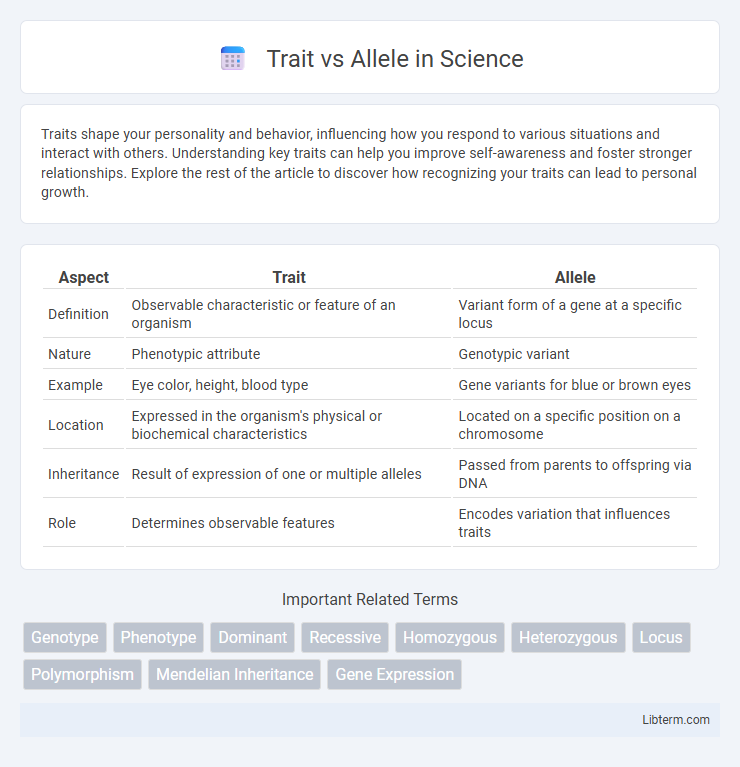Traits shape your personality and behavior, influencing how you respond to various situations and interact with others. Understanding key traits can help you improve self-awareness and foster stronger relationships. Explore the rest of the article to discover how recognizing your traits can lead to personal growth.
Table of Comparison
| Aspect | Trait | Allele |
|---|---|---|
| Definition | Observable characteristic or feature of an organism | Variant form of a gene at a specific locus |
| Nature | Phenotypic attribute | Genotypic variant |
| Example | Eye color, height, blood type | Gene variants for blue or brown eyes |
| Location | Expressed in the organism's physical or biochemical characteristics | Located on a specific position on a chromosome |
| Inheritance | Result of expression of one or multiple alleles | Passed from parents to offspring via DNA |
| Role | Determines observable features | Encodes variation that influences traits |
Understanding Traits: Definition and Importance
Traits are observable characteristics of an organism, such as eye color or height, determined by genetic information passed from parents to offspring. Alleles are different versions of a gene that influence specific traits by providing variations in genetic code, resulting in diverse phenotypic expressions. Understanding traits and their associated alleles is crucial for studying heredity, genetic diversity, and predicting inherited conditions.
What Is an Allele? A Genetic Overview
An allele is a specific variant of a gene located at a particular position on a chromosome, influencing distinct traits in an organism. Each individual inherits two alleles for each gene, one from each parent, which can be identical (homozygous) or different (heterozygous), impacting the organism's phenotype. Understanding alleles is crucial for studying genetic diversity, inheritance patterns, and the molecular basis of traits.
Key Differences Between Traits and Alleles
Traits represent observable characteristics such as eye color or height, determined by the expression of one or more genes. Alleles are specific versions of a gene that influence the variation in a particular trait, with each individual inheriting two alleles for each gene, one from each parent. Unlike traits, which are phenotypic outcomes, alleles are the genetic variations responsible for the diversity in traits.
How Traits Are Expressed in Organisms
Traits in organisms are expressed through the interaction of alleles, which are different versions of a gene located at specific loci on chromosomes. Each trait's phenotype depends on the combination of dominant and recessive alleles inherited from the parents, influencing characteristics such as eye color, height, and disease susceptibility. Gene expression mechanisms regulate how alleles produce proteins, ultimately determining the observable traits in an organism.
The Role of Alleles in Inheritance
Alleles are different versions of a gene that determine specific traits by encoding variations in the protein products. These genetic variants are inherited from parents, with each individual receiving one allele from each parent, influencing dominant and recessive trait expression. The combination of alleles forms a genotype, which directly impacts the phenotype observed in an organism.
Genotype vs. Phenotype: Connecting Traits and Alleles
Genotype represents the genetic makeup of an organism, consisting of specific alleles inherited from parents that encode traits. Phenotype is the observable expression of these traits, influenced by the interaction of alleles and environmental factors. Understanding the relationship between genotype and phenotype clarifies how alleles contribute to the variation in traits within populations.
Dominant and Recessive Alleles Explained
Dominant alleles express their traits even when only one copy is present, masking the effect of recessive alleles, which require two copies to display their characteristics. Traits result from specific combinations of dominant and recessive alleles inherited from parents, determining physical and genetic variation. Understanding dominant and recessive allele interactions is essential for predicting phenotypic outcomes in genetic inheritance.
Examples of Traits and Corresponding Alleles
Eye color illustrates a trait with alleles such as the brown allele (B) and blue allele (b) influencing the phenotype. Hair texture varies as a trait determined by alleles like the curly hair allele (C) and straight hair allele (c). Blood type serves as a trait controlled by multiple alleles, including A, B, and O, defining an individual's blood group.
Trait Variation: The Impact of Multiple Alleles
Trait variation is significantly influenced by the presence of multiple alleles at a single gene locus, expanding the diversity of phenotypes beyond simple dominant-recessive relationships. Unlike the binary effect of two alleles, multiple alleles can create a spectrum of trait expressions, as seen in blood group systems such as the ABO blood type with three different alleles (IA, IB, i). This allelic variation enhances genetic diversity and allows populations to adapt more flexibly to environmental changes through a broader range of inherited traits.
Real-World Applications: Traits, Alleles, and Genetic Research
Traits such as eye color and blood type are influenced by specific alleles, which are alternative forms of a gene found at the same locus on a chromosome, playing a crucial role in genetic diversity. In genetic research, understanding the relationship between alleles and traits enables advancements in personalized medicine, where treatments are tailored based on an individual's genetic makeup. Agricultural biotechnology also benefits from this knowledge by developing crops with desirable traits like drought resistance through selective breeding and genetic modification targeting particular alleles.
Trait Infographic

 libterm.com
libterm.com